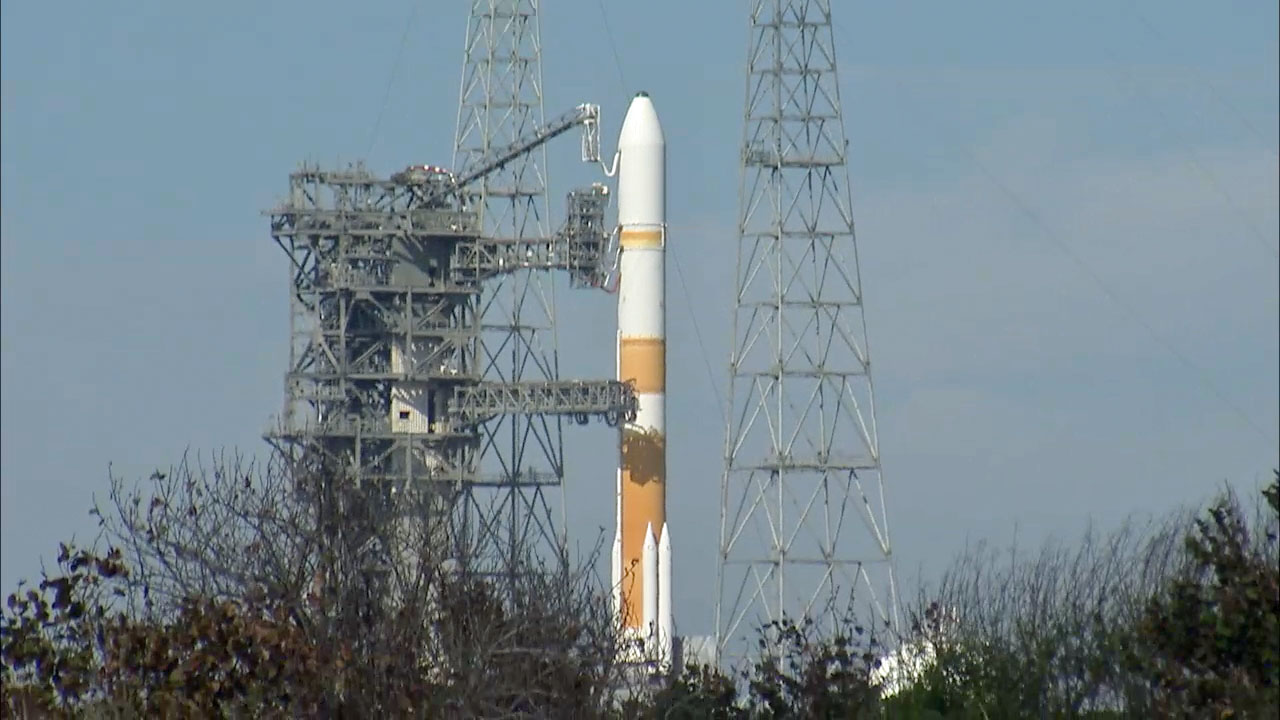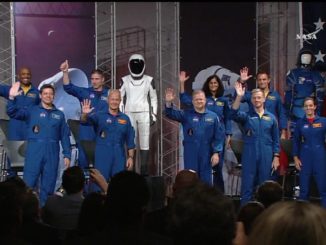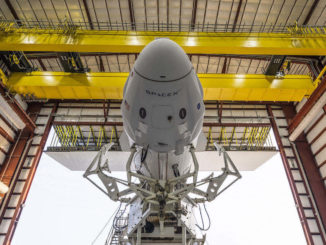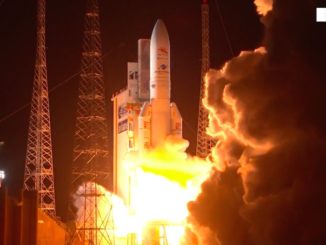
The addition of a U.S. Air Force communications satellite has capped the assembly of a 218-foot-tall (66-meter) United Launch Alliance Delta 4 rocket at Cape Canaveral set for liftoff the evening of March 13.
The Air Force’s 10th Wideband Global SATCOM communications satellite joined the Delta 4 rocket at Cape Canaveral’s Complex 37 launch pad early Tuesday after an overnight trip from the Astrotech spacecraft processing facility in nearby Titusville.
After arriving from its factory in Southern California late last year, the Boeing-built communications satellite was fueled with maneuvering propellants at the Astrotech facility, then encapsulated inside the Delta 4 rocket’s payload shroud, emblazoned with the mission’s official insignia.
Cocooned inside the protective 47-foot-tall (14-meter) payload fairing on a special transporter, the WGS 10 satellite left the Astrotech facility late Monday under a security escort for the low-speed journey to the launch pad.
The convoy included equipment to supply conditioned air to the satellite during the trip to the pad.
Cranes at Complex 37 raised the spacecraft and payload fairing inside the pad’s mobile gantry, then workers carefully lowered the satellite on the rocket’s second stage. Teams planned to spend the next couple of weeks verifying the mechanical and electrical connections between the Delta 4 launcher and the WGS 10 spacecraft, convening readiness reviews, and practicing countdown procedures.
Liftoff of the Delta 4 rocket is scheduled for March 13, during a launch window opening at 6:58 p.m. EDT (2258 GMT). The launch window extends until 9:04 p.m. EDT (0104 GMT).

Boosted by an Aerojet Rocketdyne hydrogen-fueled RS-68A main engine and four strap-on solid rocket motors built by Northrop Grumman Innovation Systems, the Delta 4 rocket will head east from Cape Canaveral to place the WGS 10 spacecraft into an elliptical geostationary transfer orbit, a waypoint on the satellite’s journey to an operating post more than 22,000 miles (nearly 36,000 kilometers) over the equator.
WGS 10 will join a military satellite fleet to route classified and unclassified data and video, supporting U.S and allied forces around the world. Featuring a digital channelizer, WGS 10 will relay high-data-rate communications in X-band and Ka-band frequencies during a mission expected to last at least 14 years.
The nine previous WGS satellites all launched on ULA rockets — the first two on Atlas 5s in 2007 and 2009, and the following seven on Delta 4s.
The Wideband Global SATCOM fleet is the U.S. Defense Department’s highest capacity satellite communications network.
The launch March 13 will be ULA’s second mission of the year, the second Delta 4 flight of the year, and the third launch from Florida’s Space Coast overall so far in 2019.
The mission will be the 39th flight by a Delta 4 rocket since the launcher family debuted in 2002, and the eighth launch by a Delta 4 flying in the “5,4” configuration with a 5-meter (16-foot) diameter payload fairing and four solid rocket boosters.
The Delta 4’s first and second stages, covered in insulating orange foam, rolled out of ULA’s Horizontal Integration Facility to the launch pad Jan. 24, then hoisted vertical. The four solid rocket boosters, measuring 60 inches (1.5 meters) in diameter and 53 feet (16 meters) long, were added around the base of the Delta 4 launcher in early February.

The upcoming flight will be the penultimate launch by a Delta 4 rocket with a single first stage core, a medium-lift variant ULA plans to retire later this year as part of the company’s strategy to streamline its operations and cut costs.
The Delta 4 is more expensive than ULA’s Atlas 5 rocket family, so the company decided in 2014 to phase out most of the Delta 4 configurations.
ULA, a 50-50 joint venture between Boeing and Lockheed Martin, will continue flying the Delta 4-Heavy through the early 2020s. The Delta 4-Heavy is composed of three liquid-fueled first stage cores connected together to haul heftier payloads into space.
Meanwhile, ULA is developing a new rocket named the Vulcan set for an inaugural flight in 2021. The Vulcan launcher will eventually fully replace the entire Atlas and a Delta rocket families.
The final single-core Delta 4 rocket is scheduled for launch from Cape Canaveral in July with a GPS navigation satellite.
Email the author.
Follow Stephen Clark on Twitter: @StephenClark1.



